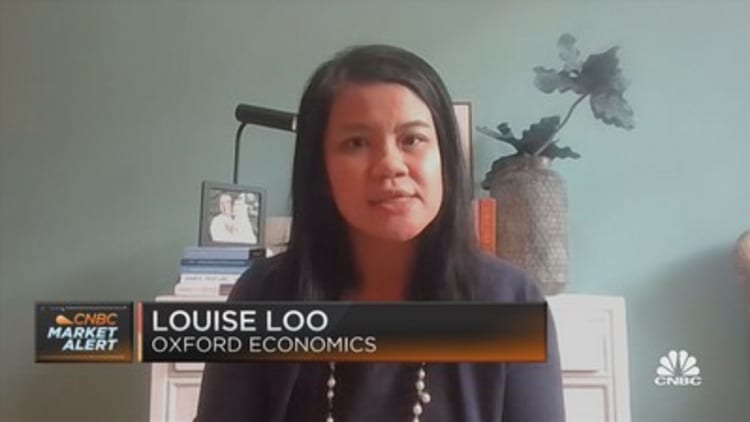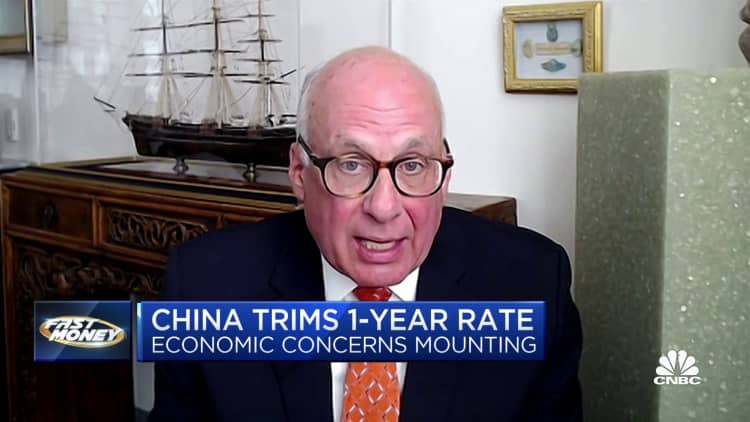SHENZHEN, CHINA – MARCH 09: View of high commercial and residential buildings on March 9, 2016 in Shenzhen, China. General economic slowdown continues in China while the property price and stock bubble faces risk. (Photo by Zhong Zhi/Getty Images)
Zhong Zhi | Getty Images News | Getty Images
China’s economic challenges have given rise to deflationary pressures that present a global concern and are likely to accelerate in the coming quarters, according to economists.
Beijing’s deteriorating economic fundamentals have become starkly apparent in recent months, with July’s data broadly missing expectations and the National Bureau of Statistics suspending its publication of youth unemployment figures as numbers soared to record highs.
Credit data for July also showed a slump in borrowing demand from businesses and households and problems have persisted in the country’s massive real estate sector, with once-healthy developer Country Garden on the brink of default and heavily indebted property giant Evergrande Group filing for bankruptcy protection in the U.S. earlier this month.
China’s headline consumer price index fell 0.3% year-on-year in July to register deflation for the first time in more than two years, presenting an opposing problem to that faced by major economies in the West.
Though some of the headline weakness could be attributed to transitory factors such as lower energy and pork prices, core inflation has also been weighed down by falling prices in shelter and related categories due to the ailing property sector.
“Despite changing linkages between China and the global economy as Beijing tries to transition to a consumption-led growth model and trade tensions remain elevated with the West, China is still the world’s manufacturer,” said Pimco Economist and Managing Director Tiffany Wilding.
“As a result, Chinese economic weakness and falling prices (especially Chinese producer prices) are likely to spill over into global markets — near-term good news for the Western central banks’ fight against elevated inflation.”
While Western economies emerged from the Covid-19 pandemic with elevated inflation amid constrained supply and resurgent demand, China has not experienced the same dynamics since ending its strict zero-Covid measures, as its domestic manufacturing power helped mitigate supply bottlenecks and global commodity prices moderated.
Yet in a research note last week, Wilding and Pimco China Economist Carol Liao noted that domestic demand has since faltered and left China with idle capacity, while deleveraging in the property and local government financing sectors have deepened disinflationary pressures and hit domestic investment, leading to “broad-based excess capacity in manufacturing.”
“What’s more, the government’s reaction to these weakening fundamentals has been far from sufficient. Indeed, a government-led push to stimulate and stabilize growth through easy credit, especially to state-owned enterprises and for infrastructure investment, has not been enough to offset the drag from property market, as the flow of new credit to the economy has contracted over the past year,” the Pimco economists added.
China’s central bank on Friday ramped up measures to arrest a rapid depreciation in its currency on the back of the bleak round of data and fading consumer confidence, but the market seemingly remained unconvinced that Beijing was doing enough to reverse the recent trends.

Skylar Montgomery Koning, senior global macro strategist at TS Lombard, said in a research note last week that market disappointment is likely to continue as any government fiscal stimulus measures will be “stronger versions of current easing measures” rather than the “broad-based stimulus needed to revive confidence in prices.”
“China’s disappointing rebound is now feeding negatively into global sentiment and growth. This has been countered by a fairly benign global backdrop and a remarkably strong U.S. economy, but there is a fine balance for risk assets as significant dollar strength is detrimental, too,” Montgomery Koning said.
Though authorities in Beijing have attempted to push back against one-way depreciation bets against the Chinese yuan, she said the direction of travel is clear, and TS Lombard maintains a long position on the U.S. dollar against the yuan.
“Slower growth, limited stimulus, trade decline and capital outflows all point to further CNY weakness this quarter,” Montgomery Koning added.
Spillover effects: Imports and exports
Though China is recalibrating its economy to become less dependent on its traditional pillars of real estate and manufactured goods exports, Chinese manufactured products still dominate consumer goods markets, particularly in the U.S.
“According to U.S. Census Bureau data as of June, prices of goods imported from China are down 3% on average versus last year, while producer prices of consumer goods in China are down 5% in dollar terms,” Wilding and Liao noted.
“Importantly, these declines are being passed on to U.S. consumers; July marked the first time since the early days of the pandemic that U.S. consumer retail goods prices declined on a three-month annualized basis.”
This moderation dynamic is likely to transmit to other developed markets as U.S. inflationary trends have typically led the way since the pandemic, they suggested.

Secondly, exports have weakened in China in recent months. As downside risks to Chinese economic growth materialize, Wilding and Liao suggested Beijing may look to use fiscal policy to boost exports and address an emerging domestic oversupply problem, in turn flooding the global market with cheap consumer goods.
“This already appears to be happening in Germany, as Chinese exports of lower-cost electric vehicles have recently surged, while domestic price cuts may spill over into other countries,” they added.
Beyond the trade-related spillovers, a common global disinflationary pressure comes from commodity prices, where as a huge importer of commodities, Chinese domestic demand remains a key factor.
“Weak Chinese domestic investment and broad-based excess capacity in manufacturing, as well as weak sales of new homes and land, are likely to continue to depress global commodity demand,” Wilding and Liao said.
This was echoed by TS Lombard’s Montgomery Koning, who also noted that Beijing’s stimulus measures during this cycle have been consumer-driven, rather than investment-driven, meaning “renewed demand for industrial commodities has undershot expectations.”

“Deteriorating Chinese economic fundamentals have produced deflationary pressures that are already moderating inflation both in China and in the global markets served by Chinese goods,” Pimco’s Wilding and Liao concluded.
“Given the usual lags, deflationary spillovers have likely only just begun to impact global consumer markets, with discounting likely to accelerate over the coming quarters.”
The risk of more prolonged and pronounced inflationary pressure hinges on the government’s fiscal policy responses in the coming months, they added, arguing that adequate stimulus to boost domestic demand may re-accelerate inflation while inadequate policy measures could give way to a “downward spiral.”
“Persistent deflation in China would likely spill over to developed markets, as a weaker yuan and an elevated inventory-to-sales ratios lower the cost of Chinese goods abroad – a development central bankers in developed markets would likely welcome,” they added.
Uncertainty over China’s recovery potential has cast a dark cloud over global markets in recent weeks, and Deutsche Bank strategists Maximilian Uleer and Carolin Raab said in a research note Wednesday that the central bank’s rate cuts and the government’s promise of further fiscal stimulus have done little to soothe concerns in Europe.
“European companies are heavily dependent on Chinese demand and generate about 10% of their profits in China,” they highlighted.
“We still believe that a stabilization of the Chinese economy in the fourth quarter is likely. ‘Likely’ is unfortunately not enough. We wait for data to improve before we turn positive on markets again.”
